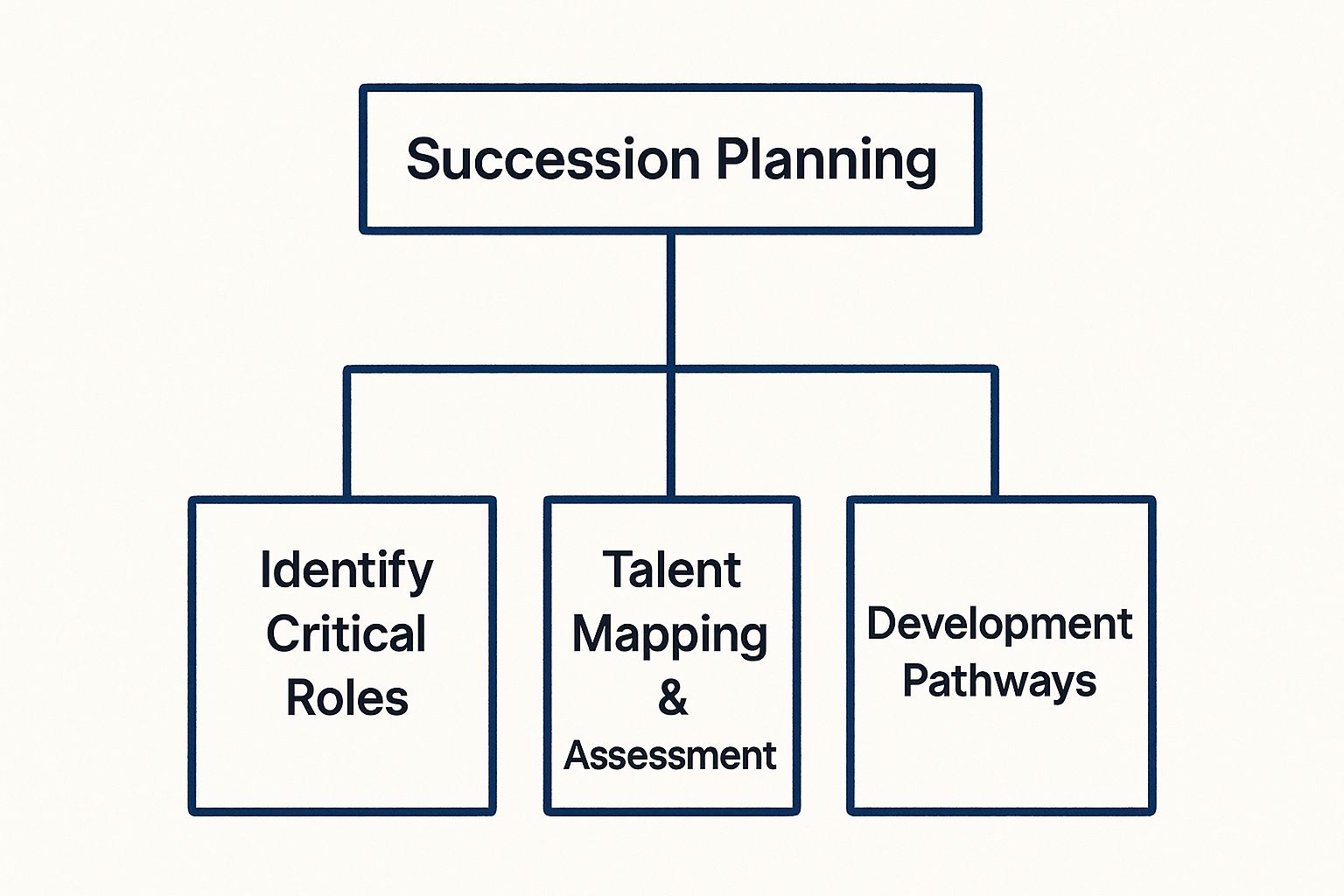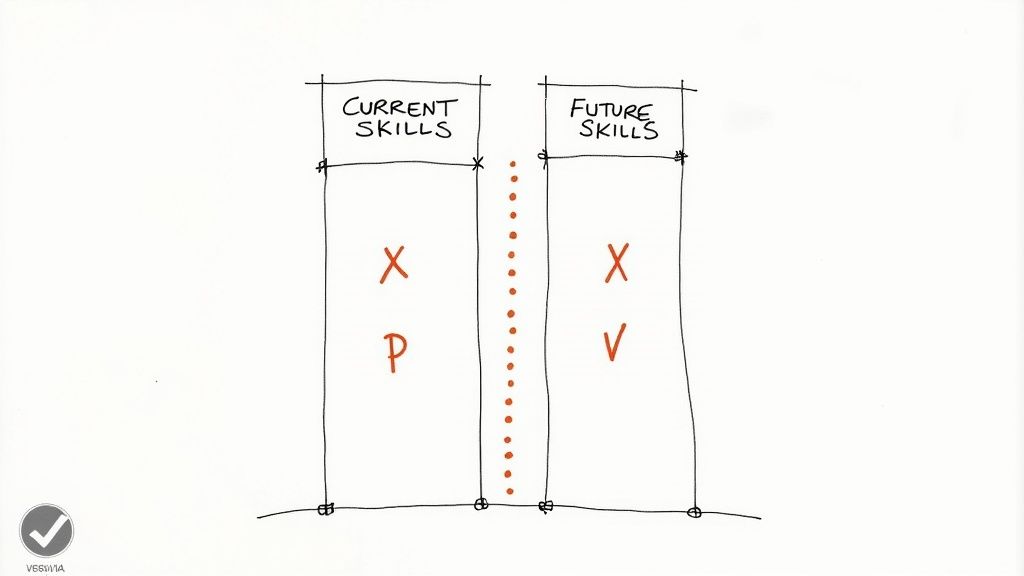October 3, 2025
Top Workforce Planning Strategies for Recruiters in 2025

In the fast-paced world of talent acquisition, being reactive is a recipe for falling behind. Winning the war for talent requires foresight, not just speed. Strategic workforce planning is the practice of aligning your recruitment efforts with long-term business goals, ensuring you have the right people with the right skills in the right roles at the right time.
This isn't just an HR buzzword; it's a critical business function that transforms recruiters from order-takers into strategic partners. Moving beyond filling immediate vacancies to building a sustainable talent pipeline can dramatically reduce hiring costs, improve retention, and boost organizational resilience. The right workforce planning strategies give you a competitive edge, allowing you to anticipate needs before they become urgent crises.
This guide unpacks nine essential workforce planning strategies, providing actionable insights for talent acquisition leaders to build a future-proof team. You'll learn how to implement practical approaches like scenario planning, skills gap analysis, and predictive analytics to move from a reactive hiring model to a proactive talent acquisition engine. Let's explore how to build the workforce your organization needs for tomorrow, today.
1. Succession Planning: Building Your Leadership Bench from Within
Succession planning is a forward-thinking workforce planning strategy focused on identifying and nurturing internal talent to fill future leadership and mission-critical roles. Instead of reacting to vacancies, this proactive approach ensures business continuity and preserves institutional knowledge by preparing a pipeline of qualified internal candidates. By investing in high-potential employees, organizations reduce hiring costs, shorten ramp-up times, and boost employee morale and retention.
How to Implement Succession Planning
Effective succession planning goes beyond simply naming a replacement. It requires a structured, multi-stage process to identify, assess, and develop future leaders. Companies like General Electric and Johnson & Johnson have famously used this approach to build robust leadership benches that can adapt to market changes.
This infographic breaks down the core hierarchical components of a successful succession planning framework.

The visualization shows that identifying critical roles is the foundational step, which then informs who to assess and how to develop them.
Actionable Tips for Success
To get started, focus on these key actions:
- Start Early: Begin identifying potential successors for critical roles 12-36 months before an anticipated departure.
- Create a Talent Pool: Instead of a single "heir," develop a pool of 2-3 qualified candidates for each key position to build depth and flexibility.
- Integrate and Communicate: Link succession efforts with performance management systems for consistent evaluation. Transparently communicate development opportunities to keep high-potentials engaged.
To truly build your leadership bench from within, exploring proven succession planning strategies is essential for identifying and developing future leaders.
2. Skills Gap Analysis: Bridging the Divide Between Current and Future Needs
Skills gap analysis is a systematic workforce planning strategy used to identify the disparity between the skills your current workforce possesses and the capabilities required to achieve future business goals. This diagnostic approach allows organizations to pinpoint specific talent shortages before they become critical, informing decisions on whether to train, hire, or outsource to remain competitive. By quantifying these gaps, you can create targeted talent development and acquisition plans that directly support strategic objectives.

This process highlights how comparing current skills against future requirements is central to identifying the critical gaps that need to be addressed.
How to Implement Skills Gap Analysis
Effective skills gap analysis is a data-driven process that involves defining future needs, assessing current competencies, and analyzing the results to create a clear action plan. Companies like AT&T have successfully used this method to launch massive reskilling initiatives, preparing their workforce for the transition from legacy hardware to software-centric networks. Similarly, Amazon continuously analyzes technical skill gaps to fuel its training programs for in-demand roles in cloud computing and AI.
For a deeper dive into the challenges many organizations face, explore this article about understanding the current skills gap and why many workers require upskilling.
Actionable Tips for Success
To get started, focus on these key actions:
- Involve Department Heads: Collaborate with managers to accurately define the critical skills needed for their teams to succeed now and in the future.
- Use Multiple Data Sources: Combine performance reviews, skills assessments, manager feedback, and self-evaluations for a comprehensive and accurate picture.
- Prioritize by Business Impact: Focus on closing the skills gaps that pose the greatest risk to achieving your organization's most important strategic goals.
A skills gap analysis is the foundation for a more targeted talent strategy, and you can learn more about skills-based hiring to directly address the capabilities your organization needs most.
3. Scenario Planning: Preparing Your Workforce for an Uncertain Future
Scenario planning is a strategic method that prepares an organization for various plausible futures by creating detailed, alternative narratives of what might happen. Unlike forecasting, which predicts a single outcome, this workforce planning strategy develops multiple responses based on potential market shifts, technological disruptions, or economic changes. This proactive approach builds organizational resilience, enabling talent acquisition leaders to pivot their workforce strategies effectively when faced with unexpected events.
How to Implement Scenario Planning
Effective scenario planning involves more than just brainstorming worst-case outcomes. It is a structured process of identifying key uncertainties, building coherent narratives around them, and developing flexible workforce plans for each. Companies like Shell have famously used this method to navigate oil crises, while financial services firms used it to prepare their talent and operational models for the impacts of Brexit. This approach ensures you are not caught off guard by major external shifts.
By envisioning different futures, you can preemptively address potential talent gaps, surpluses, or skill mismatches before they become critical problems.
Actionable Tips for Success
To get started with this forward-thinking workforce planning strategy, focus on these key actions:
- Develop 3-4 Plausible Scenarios: Create a manageable number of distinct yet realistic scenarios. Include a mix of optimistic, pessimistic, and neutral "business as usual" outcomes to cover a range of possibilities.
- Involve Cross-Functional Teams: Engage leaders from finance, operations, and marketing in the scenario development process. This diversity of perspectives ensures your workforce plans are holistic and aligned with broader business objectives.
- Create Trigger Points: For each scenario, define specific trigger points or leading indicators that signal a particular future is unfolding. This allows you to activate the corresponding workforce plan in a timely and decisive manner.
4. Workforce Segmentation: Differentiating Talent for Strategic Impact
Workforce segmentation is one of the most powerful workforce planning strategies, involving the division of employees into distinct groups based on criteria like strategic importance, skills, performance, or potential. This approach allows organizations to move beyond one-size-fits-all talent management, enabling them to apply differentiated strategies and allocate resources more effectively. By tailoring investments in high-impact segments, companies can maximize their return on talent and drive key business outcomes.
How to Implement Workforce Segmentation
Effective segmentation requires a clear framework for classifying talent, a concept famously popularized by McKinsey & Company’s A-B-C player model. This involves identifying which roles have a disproportionate impact on business value and which employees possess the critical skills to excel. For instance, Google differentiates compensation and development opportunities significantly for its top performers in mission-critical engineering roles, ensuring their retention and engagement. Unilever also uses talent pool segmentation to manage its leadership development pipeline, focusing intensive resources on high-potential individuals.
This strategic differentiation ensures that your most valuable resources are directed where they can generate the greatest impact on organizational performance.
Actionable Tips for Success
To get started with this targeted approach, focus on these key actions:
- Use Objective Criteria: Base your segments on data-driven, objective criteria like performance metrics, skill assessments, and role criticality to avoid bias.
- Communicate with Transparency: Clearly communicate the rationale behind the segmentation process to maintain trust and ensure employees understand the pathways for development and mobility between segments.
- Review and Adapt Regularly: The needs of the business and the skills of the workforce evolve. Regularly review and adjust your segmentation model to ensure it remains aligned with current strategic priorities.
5. Predictive Analytics in Workforce Planning
Predictive analytics is a data-driven workforce planning strategy that uses statistical algorithms, machine learning, and data mining to analyze historical workforce data and forecast future trends. This approach moves beyond reactive decision-making by enabling organizations to anticipate future staffing needs, identify flight risks, and optimize talent management. By leveraging predictive models, companies like Google and IBM have transformed their HR functions, making them more precise, proactive, and aligned with strategic business goals.

This data-centric approach helps answer critical questions like, "Which high-performers are most likely to leave in the next six months?" or "What are the key attributes of our most successful hires?" The answers empower leaders to intervene proactively and refine their talent acquisition and retention strategies.
How to Implement Predictive Analytics
Successfully implementing predictive analytics requires a systematic approach that begins with quality data and evolves toward sophisticated modeling. It's not about replacing human judgment but augmenting it with powerful, data-backed insights. For instance, Walmart uses algorithms to optimize scheduling, ensuring stores are adequately staffed during peak hours while improving employee work-life balance. Similarly, Google's famous Project Oxygen used data to identify the key behaviors of effective managers, fundamentally reshaping its leadership development programs.
This process involves gathering and cleaning relevant data, building and testing predictive models, and translating the outputs into actionable HR strategies.
Actionable Tips for Success
To integrate this powerful strategy into your workforce planning, concentrate on these foundational steps:
- Start with Clean Data: Ensure your historical HR data on hiring, performance, and attrition is accurate, complete, and reliable. Garbage in, garbage out is the cardinal rule of analytics.
- Begin with Simple Models: Don't aim for complex machine learning models from day one. Start by analyzing key trends like employee turnover rates or time-to-fill metrics before advancing.
- Validate and Iterate: Regularly test your models against actual outcomes to ensure their accuracy and predictive power. Continuously refine your algorithms as new data becomes available.
- Combine Insights with Judgment: Use predictive insights as a powerful input for decision-making, not a replacement for human expertise and strategic context.
6. Agile Workforce Planning: Responding to Change with Speed and Flexibility
Agile workforce planning adapts principles from software development to create a dynamic, iterative, and responsive talent strategy. Instead of rigid annual plans, this approach uses short, cyclical sprints to continuously assess business needs and realign talent resources accordingly. It emphasizes cross-functional collaboration and real-time data to make quick, informed decisions, enabling organizations to pivot swiftly in volatile market conditions. This model boosts organizational resilience and ensures the workforce is always aligned with immediate strategic priorities.
How to Implement Agile Workforce Planning
Adopting agile workforce planning means shifting from a top-down, annual process to a continuous, collaborative effort. It involves creating dedicated, cross-functional teams that meet regularly to review talent gaps, forecast short-term needs, and adjust plans based on new data and business feedback. Companies like Spotify and ING Bank have successfully implemented this by organizing their workforce into autonomous squads and tribes, allowing for rapid deployment of talent to the most critical projects without bureaucratic delays.
This iterative cycle ensures that workforce planning strategies remain relevant and effective, rather than becoming outdated documents.
Actionable Tips for Success
To effectively implement this flexible approach, focus on these key actions:
- Implement Short Planning Sprints: Break down the annual planning cycle into quarterly or even monthly "sprints" to review priorities and reallocate resources.
- Create Cross-Functional Planning Teams: Assemble teams with representatives from HR, finance, and various business units to ensure a holistic view of organizational needs.
- Use Real-Time Data for Decisions: Leverage analytics and HR dashboards to monitor key metrics like attrition, time-to-fill, and skill gaps continuously, not just during formal reviews.
To support this modern approach, understanding the role of digital transformation in HR is crucial for leveraging the right technology and data.
7. Contingent Workforce Strategy: Harnessing Flexibility and Specialized Skills
A contingent workforce strategy is a comprehensive approach to managing and integrating non-traditional workers such as freelancers, contractors, and consultants. Instead of viewing these roles as temporary fixes, this strategy treats them as a core component of the overall workforce, providing organizational agility. This approach allows businesses to scale resources up or down based on project demands, access specialized skills on-demand, and control labor costs without the overhead of permanent hires.
How to Implement a Contingent Workforce Strategy
An effective contingent workforce strategy requires formal processes for sourcing, onboarding, managing, and offboarding non-permanent staff. It’s about creating a structured program that aligns with business goals, ensures compliance, and integrates external talent with full-time teams. Companies like Microsoft and Procter & Gamble leverage sophisticated contingent programs to tap into global talent pools and accelerate innovation by bringing in outside experts for specific initiatives.
This structured approach ensures that temporary talent contributes effectively while minimizing legal and operational risks, making it a powerful element of modern workforce planning strategies.
Actionable Tips for Success
To get started, focus on these key actions:
- Establish Clear Onboarding: Develop a streamlined onboarding process specifically for contractors that covers project goals, communication protocols, and access to necessary systems.
- Utilize Technology: Implement a Vendor Management System (VMS) or a freelancer management platform to centralize tracking, payments, and performance evaluation.
- Ensure Compliance and Integration: Clearly define the scope of work and worker classification to comply with labor laws. Foster a collaborative environment where contingent workers feel integrated with permanent staff to maximize their contributions.
To build a robust and flexible talent ecosystem, exploring platforms like Upwork can provide the tools needed to manage a contingent workforce at scale.
8. Workforce Demand Forecasting: Predicting Future Staffing Needs with Data
Workforce demand forecasting is a quantitative strategy that uses historical data, business projections, and statistical models to predict future staffing requirements. Rather than relying on guesswork, this analytical approach helps organizations anticipate the number and type of employees needed across different roles, departments, and time periods. By systematically planning for recruitment, training, and resource allocation, businesses can align their talent supply directly with anticipated operational demands.
How to Implement Workforce Demand Forecasting
Effective demand forecasting is a systematic process, not a one-time calculation. It involves analyzing past trends, incorporating future business goals, and selecting appropriate statistical models to project staffing needs. Companies like UPS use sophisticated models to predict the massive seasonal hiring required for the holiday season, while Starbucks forecasts barista needs based on store traffic patterns and new product launches. This data-driven workforce planning strategy ensures optimal staffing levels, preventing both understaffing that hurts service and overstaffing that inflates labor costs.
This systematic approach transforms talent acquisition from a reactive function into a proactive, strategic business partner.
Actionable Tips for Success
To get started with accurate forecasting, focus on these key actions:
- Use Multiple Forecasting Methods: Combine several models (e.g., trend analysis, regression analysis) to create a more robust and reliable forecast.
- Incorporate Business Seasonality: Adjust projections for predictable peaks and troughs in business activity, such as seasonal retail rushes or quarterly project deadlines.
- Regularly Validate and Update Models: Continuously test your models against actual outcomes and update them with new data to maintain their accuracy and relevance over time.
9. Internal Mobility and Career Pathing
Internal mobility and career pathing are workforce planning strategies focused on creating structured pathways for employee advancement and lateral movement within the organization. Rather than defaulting to external hires, this approach prioritizes developing and retaining existing talent. It provides clear progression opportunities and facilitates internal job transitions to meet evolving business needs, boosting employee engagement and retention.
How to Implement Internal Mobility and Career Pathing
Effective implementation requires more than an internal job board. It involves a systematic approach to mapping career journeys and aligning employee development with organizational goals. Companies like LinkedIn and Accenture have excelled by building frameworks that define skills-based career progressions, making it clear how an employee can advance or pivot within the company. This creates a culture where employees see a long-term future.
By mapping out potential career progressions, organizations can proactively identify skill gaps and provide targeted development opportunities, ensuring they have the right talent ready for future challenges.
Actionable Tips for Success
To build a robust internal mobility program, focus on these key actions:
- Map Clear Career Paths: Visually outline potential vertical and lateral moves from each role, clarifying the skills and experience needed for each step.
- Invest in Skills Development: Offer training, mentorship, and on-the-job learning opportunities that align with future role requirements.
- Promote Opportunities Transparently: Ensure all internal job openings are communicated widely and the application process is straightforward and fair.
- Use Mobility Metrics: Track key data points like internal fill rate, promotion rate, and employee turnover to measure the program's effectiveness and identify areas for improvement.
Fostering a culture of internal growth not only fills critical roles efficiently but also significantly impacts long-term recruiting and retention efforts by showing a clear commitment to employee development.
Workforce Planning Strategies Comparison Table
From Planning to Action: Future-Proofing Your Talent Strategy
Navigating the complexities of the modern talent landscape requires more than just reactive hiring. As we've explored, a proactive and strategic approach is essential for long-term success. The nine workforce planning strategies detailed in this article, from meticulous Succession Planning to the dynamic flexibility of an Agile Workforce Planning model, provide a comprehensive toolkit for talent acquisition leaders aiming to build a resilient and competitive organization.
Each strategy offers a unique lens through which to view your talent ecosystem. By conducting a thorough Skills Gap Analysis, you identify critical competencies for the future. Through Scenario Planning, you prepare your organization for multiple potential business realities, ensuring you are never caught off guard. And by embracing Predictive Analytics, you can transform raw data into a powerful forecasting tool that informs hiring decisions and mitigates risk.
Synthesizing Strategy into Actionable Steps
The true power of these concepts lies not in their isolated application but in their integration. A robust talent plan is not a static document; it is a living, breathing framework that adapts to the evolving needs of your business. The journey from theory to implementation can seem daunting, but it doesn't have to be an all-or-nothing endeavor.
To get started, consider these actionable next steps:
- Prioritize Based on Pain Points: Select one or two workforce planning strategies that directly address your most urgent challenges. Are you struggling with high turnover in critical roles? Start with Internal Mobility and Career Pathing. Facing an unpredictable market? Focus on Scenario Planning.
- Build a Cross-Functional Team: Effective workforce planning involves more than just HR. Partner with finance, operations, and department heads to gain a holistic view of business objectives and talent needs. This collaboration ensures buy-in and aligns talent strategy with broader corporate goals.
- Embrace a Data-First Mindset: The success of any strategy hinges on quality data. Begin by auditing your current data sources. Identify what information you have and what you need to capture to effectively implement strategies like Workforce Demand Forecasting or Predictive Analytics.
The Strategic Imperative of Proactive Planning
Ultimately, mastering these workforce planning strategies elevates talent acquisition from a transactional function to a core strategic pillar of the organization. You move from simply filling open requisitions to architecting a workforce that is not only prepared for today's challenges but is also equipped for the opportunities of tomorrow. This forward-thinking approach creates a significant competitive advantage, enabling your organization to pivot faster, innovate more effectively, and attract and retain top-tier talent. By investing in strategic planning, you are investing directly in the future vitality and success of your business.
Ready to supercharge your talent strategy with intelligent technology? Klearskill leverages AI to automate screening, identify critical skills gaps, and provide the data-driven insights you need to execute effective workforce planning. Discover how you can build a future-proof talent pipeline by visiting Klearskill today.
